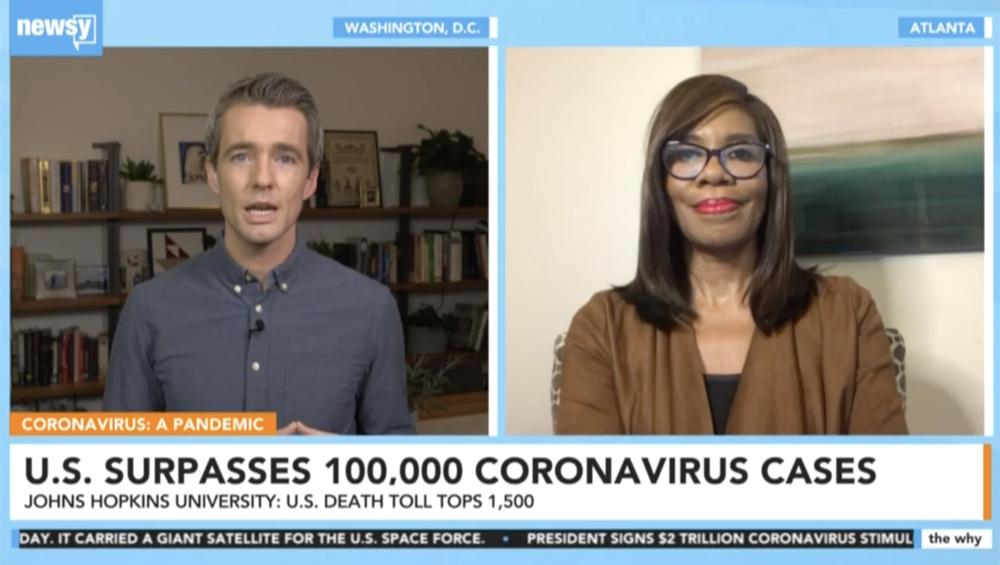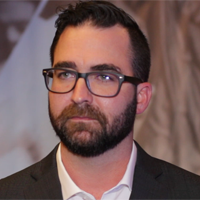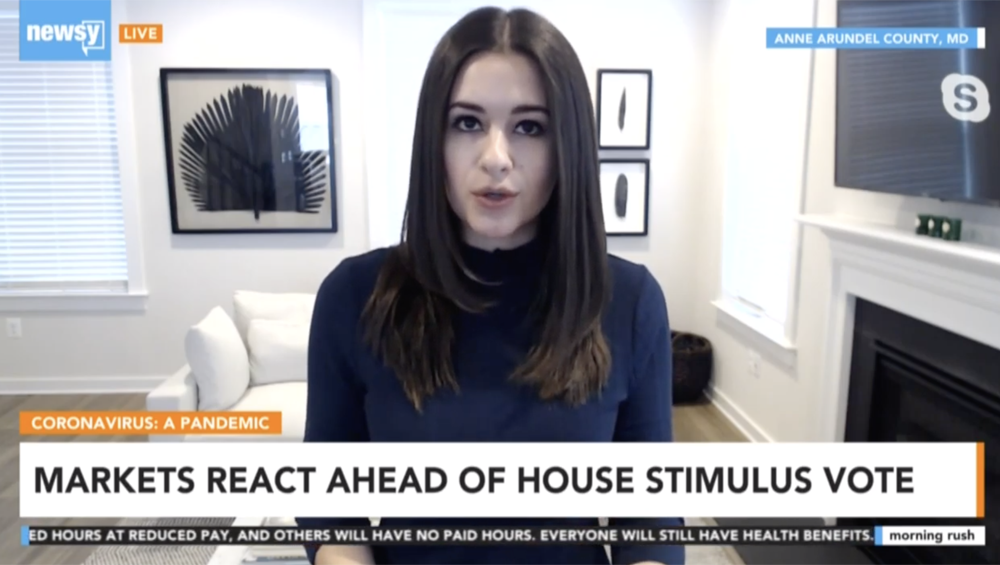
For Newsy, Digital Nativity Aided Its Virus Pivot

When the pandemic came, Newsy was ready.
The E.W. Scripps-owned news organization faced the coronavirus outbreak with about as many advantages as a newsroom could hope for: digitally native, technologically limber, staffed by and pitched to a mostly millennial cadre.
The world went sideways, and Newsy scarcely missed a beat turning with it. CEO Blake Sabatinelli says that’s because Newsy was built that way.

CEO Blake Sabatinelli
“We come from a different perspective than a lot of the traditional folks in broadcasting and cable because we were a digital newsroom and did everything remotely before,” he says, noting it could pivot “in a much nimbler way than an organization that is heavily reliant on its studio operations.”
Christina Hartman, VP of news, says essentially 100% of staffers are now working from home. “Other than select original reporting missions where we feel actual witnessing is really important, all our live programming is happening from home,” she says.
Newsy’s digital nativity — it iterates primarily as an OTT channel but is available also on other digital platforms and as a cable network — enabled a fast shift once social distancing became a necessity.
“We have always had a digital infrastructure,” Hartman says. “At the point at which we made the call to move our live programming staff home, it was really only a matter of our technical staff, our directors and our engineers basically moving computers.”
As to Newsy’s satellite operation, Sabatinelli says the organization already hubs with Scripps’ enterprise team in Indianapolis where Ray Thurber, VP of engineering, has been aggressively working to virtualize all operations.
“We still have a satellite uplink, but the production and distribution of our content is making it to our end point based very heavily on our own fiber network and our own closed infrastructure,” Sabatinelli says.
Prior to the pandemic, Newsy already had a number of its staffers producing content from home. All they needed was access to iNews, file transfer services and Newsy’s CMS.
Meanwhile, “Scripps moved very quickly to increase the bandwidth of our servers so that people can access the systems that they needed to quickly,” Hartman says.
Anchors were kitted up at home with fixed cameras, lights and remote prompter setups. Remarkably, Newsy had all the gear it needed to shift entirely to remote production already on hand.
Well, almost. “We needed two TVUs,” Hartman says. “We got them from another brand within the enterprise. We had them within 24 hours of putting the call out.”
In just a week’s time in March, that speed enabled Newsy to shut the lights off first in its New York bureau, followed in short order by bureaus in Washington, Denver and Chicago, with its home base in Columbia, Mo., all but shuttering last.
“We were already a heavily dispersed newsroom,” Sabatinelli says. “It allows us to be nimble and move flexibly around stories.”
And staffers had been widely conversant with much of the digital technology that other newsrooms were playing catch up with as their own newsrooms shifted to virtual last month.
“We were already heavily using video conferencing,” Sabatinelli says. “We were already deeply integrated with Slack, so this was really just a change of work location.”
Not to mention Newsy’s staffers were generally protean in their skills both in front of and behind the cameras.
“Our staff has always been multiskilled and trained in a variety of functions,” Hartman says. “Our anchors have long self-prompted, for example.” Others have expanded their roles since the crisis began, she adds. Videographers have added editing and post-production to their jobs, for instance.

News VP Christina Hartman
Editorially, Hartman says Newsy is staying the course on its mission to “be informed, not influenced.” Pragmatically, that means keeping a sober tone in its reporting and conveying information about the pandemic in a way “that doesn’t add to [viewers’] stress or anxiety levels,” she says.
Medical experts are at the center of Newsy’s coverage, Hartman adds, and for now, it’s largely sticking with running controversial White House coronavirus task force briefings from which other cable and network news organizations have pulled back.
“Today we view it as important that our viewers have access to information coming from decision makers,” Hartman says,” though we have told our producers that if it starts to take more of a campaign rally sort of tone that it is OK to non-confrontationally come back or cut away.”
But as much as Newsy has been able to keep its plane flying straight through the severe turbulence, it still can’t help but feel the shaking.
Certainly that’s been true on the advertising front, where Sabatinelli won’t say how bad of a hit Newsy has taken. “We are still at a kind of wait-and-see moment as far as the total impact,” he says, further suggesting that the organization had a lean sales staff to begin with. “We have always been smart about the size and scale of our sales organization,” he says.
Sabatinelli also thinks the crisis has opened up an opportunity around Newsy’s largely programmatic advertising business. “What we are going to see over the next weeks and months is sustained buying where there is significantly less friction to transact,” he says.
Newsy’s leaders have also needed to grip the wheel more tightly on the communications front. Since the crisis began, they have been holding all-hands meetings every day, if only for 15 minutes so staffers can come in, ask questions and share concerns.
“The more as managers and leaders we can do to be open, honest and transparent with our team, the more we can dissipate fear or discomfort and ensure that our team is continuing to focus on the right things,” Sabatinelli says.
One of those right things is making sure staffers get enough rest to avoid burnout, so they’re encouraged to rest and take a day off when needed. “My job is to ensure that we stay on the air and that everyone is healthy and safe,” Sabatinelli says. “We will figure out the rest after.”

Bianca Facchinei reporting
Something Newsy has figured out in the meantime, however, is that its bonds with its sister companies are stronger than it initially realized.
Content sharing had been in place before the crisis began, but it has accelerated and deepened since the pandemic’s onset. Scripps’ national investigative team, for instance, has jumped in to provide in-depth stories more quickly. Local stations have ramped up collaborations. And even Court TV has lent its 20-odd producers and correspondents to the fold.
“We just realized there was a good amount of alignment with some of what we were doing and they were doing,” Hartman says. “We have collaborated on ideas and it has been phenomenal.”
Sabatinelli says that increased collaboration among Scripps properties is the biggest upshot of a difficult time. “We are working together in a different way now, coordinating and producing news that in some cases is critical or lifesaving for our viewers,” he says.
“This has been a tremendous opportunity for us to collaborate and work more together. And that is going to last. It’s going to have phenomenal, longstanding effects on the company.”
To read more TVNewsCheck coverage of how TV stations, station groups, news organizations and individuals are pivoting to work amid the coronavirus pandemic, click here.
































Comments (0)